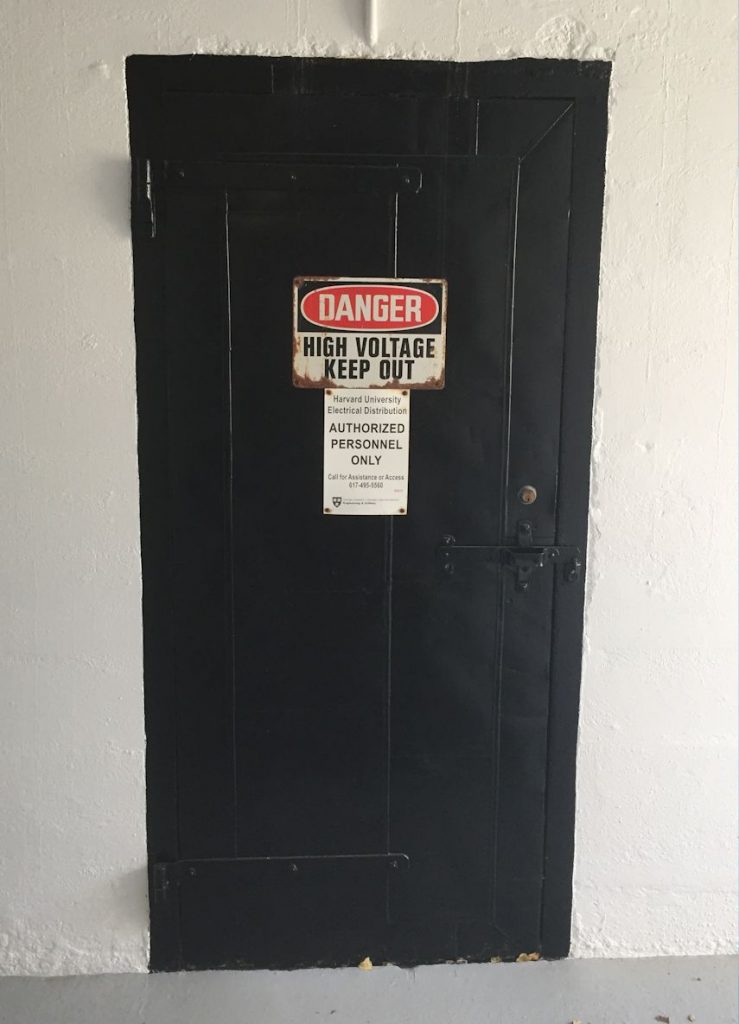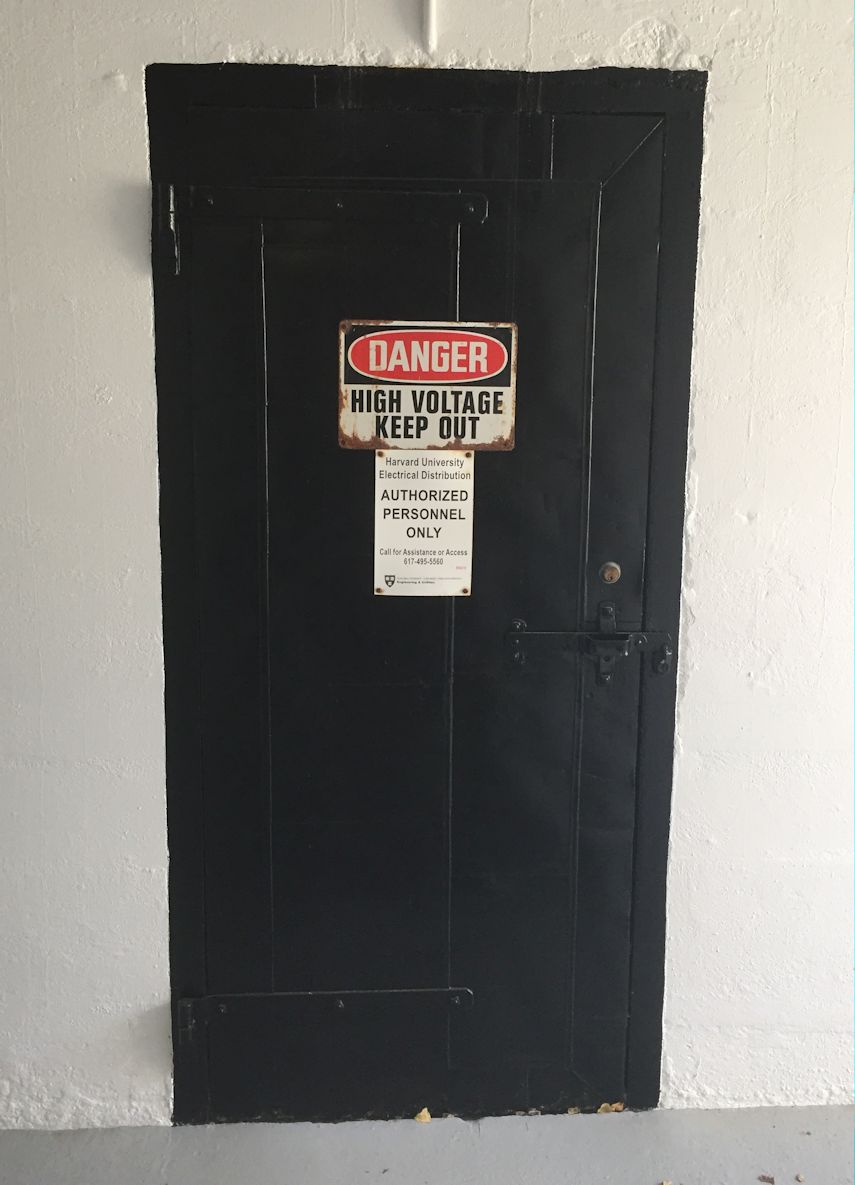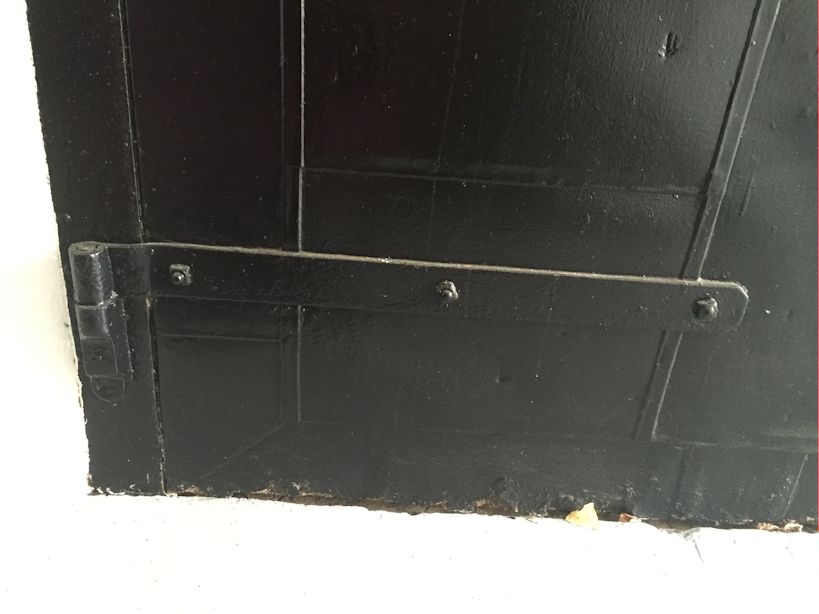Last week I took one of ou r specwriter apprentices on a field trip to Harvard Law School, a facility where I have spent a lot of time over the years. There are so many examples of different types of hardware, and I think it’s really helpful for people who are new to the industry to see them in action – pocket pivots, less-bottom-rod fire exit hardware, shear locks, overhead stops, swing-clear hinges…I think Harvard has at least one of everything. Our apprentice noticed an old electrical room door and I immediately said, “That would make a great blog post!”
r specwriter apprentices on a field trip to Harvard Law School, a facility where I have spent a lot of time over the years. There are so many examples of different types of hardware, and I think it’s really helpful for people who are new to the industry to see them in action – pocket pivots, less-bottom-rod fire exit hardware, shear locks, overhead stops, swing-clear hinges…I think Harvard has at least one of everything. Our apprentice noticed an old electrical room door and I immediately said, “That would make a great blog post!”
I’ve been asked several times – what is the difference between a swinging door with builders hardware (addressed in Chapter 6 of NFPA 80) and a swinging door with fire door hardware (covered in Chapter 7)? Swinging doors with builders hardware are the fire door assemblies that are commonly seen in modern buildings. Swinging doors with fire door hardware are occasionally found in existing buildings, but are not common today. The door that we saw at Harvard is shown in the photos on this post. I couldn’t confirm whether this is actually a fire door, but this door is constructed in the same fashion as a swinging door with fire door hardware.
When I gave someone this answer recently, he said, “But how do you know??” If “because I said so” isn’t enough, you can find more information in the NFPA 80-2016 Handbook. Section 4.6.2 describes the two categories, with the difference being the construction of the door and frame. Hollow metal doors, flush wood doors, and other types of doors are listed as examples of swinging doors with builders hardware. Examples in the handbook for swinging doors with fire door hardware include door leaves constructed of sheet metal and doors of tin-clad construction.
Builders hardware that is installed as part of a fire door assembly may be supplied by various manufacturers and will typically be marked with a symbol from one of the testing laboratories. Fire door hardware might not bear these same labels because the label on the door covers the entire assembly. So…when you’re referring to NFPA 80, Chapter 6 applies to most of the fire door assemblies supplied today. The requirements of Chapter 7 apply to very few doors in comparison.
You need to login or register to bookmark/favorite this content.








I did not know that.
Molding young minds at Harvard!!
I’ve been working with our apprentice groups for quite a few years now, and I’m so impressed with these “young minds”! They’re great!
– Lori
From the photo I would guess that the door is likely older than 1930 or so, the question would be was it correct when it was installed?
And of course the bigger question is if it would function as intended now. I would think the University has likely increased the electrical load in that closet many times since it was built and never reviewed the possibility that the potential fire load may exceed the door’s capacity and likely have never considered that the room’s construction may no longer be up to perform as they assume.
Good questions. I’m not sure of the answers, but I do know that the university is on top of their fire / life safety requirements.
– Lori
I’m still confused. You said:
“Hollow metal doors, flush wood doors, and other types of doors are listed as examples of swinging doors with builders hardware. Examples in the handbook for swinging doors with fire door hardware include door leaves constructed of sheet metal and doors of tin-clad construction”.
What is the difference between hollow metal doors and doors constructed of sheet metal?
The sheet metal and tin-clad doors that the handbook is referring to are the old doors that are made of small pieces of metal – like the one in the photo. Someone could argue that “sheet metal” and “hollow metal” doors are the same thing, but there are other clues in that section of NFPA 80 – like swinging doors with fire door hardware come with strap hinges.
– Lori
It’s true that there is a difference between fire door hardware and builders’ hardware and it is important to take the time to choose the right one. Before installing your fire door and hardware, however, it is important to understand what the safety codes are for your city before you decide which to install.
As a Fire rated doors needs ball bearing hinges, are those Ball Bearing Strap Hinges?
Hi Jack –
The requirements for swinging doors with fire door hardware are different from swinging doors with builders hardware, and the strap hinges are acceptable for these doors.
– Lori
Lori, I employ apprentice too and they often come up with new ideas to promote my company which I never though before. Indeed young minds often amazes with their results. Though in same areas they lack very much but others they perform very well.
I agree! Plus they have more energy than I do. 🙂
– Lori
We have joinery shop based in Balham specialising in bespoke wooden doors. It always nice to know few tips. http://www.aptbespokejoinery.co.uk
thanks for sharing beautiful information with us about Builders hardware
i hope you will share some more info about Builders hardware
Builders hardware